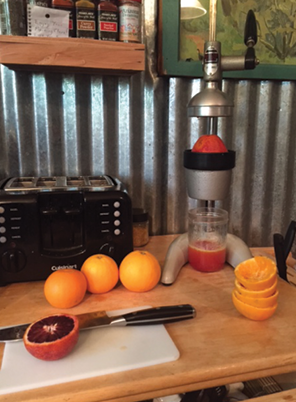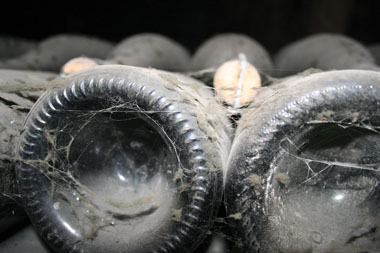
Country wine is a term often applied to just about any wine made from something other than wine grapes. Most often, that means other fruits. Sometimes, country wine is made from vegetables or with flowers or herbs. There are many recipes out there and lots of techniques for these very diverse wines.
This article is not a recipe list, but instead focuses on two of the critical measurements with country wines: How much sugar will be needed to get the desired alcohol level, and how much fruit is required to offer a pleasing profile of aroma, flavor, and appearance.
Because this range of wines is so diverse, I will address it in three categories: All-fruit, part-fruit, and fruit-flavored. The all-fruit category is also typical of making wine from grapes. For white (or rosé) wines, juice is expressed from the fruit and then that juice is fermented into wine. For red wine, the stems of the grapes are removed and the fruit is usually crushed, then fermentation takes place on the combination of juice, pulp, skin, and seeds (which are sometimes partially removed during fermentation). The red wine is pressed off of these solids after the sugar has fermented to alcohol. For other fruits, either of these practices may be applied, if appropriate for that fruit. It is very common to make apple wine (or apple cider) from the juice of apples and to make pear wine (called perry) from the juice of pears. Some of the softer berries, such as very ripe blackberries, may be fermented as a crushed “must” with the pulp in the manner of red wine. Often, cider and perry are produced with only the native fruit sugar, yielding an alcoholic beverage with beer-like alcohol levels of about 5 to 8% by volume (ABV). With almost all other non-grape fruits or juices, some sugar will be needed to supplement the natural fruit sugar to achieve a wine-like alcohol level of 10 to 14% ABV. Indeed, grape wine itself is sometimes supplemented with sugar in a process called chaptalization. By my definition here, the “all-fruit” category has no water added.
The “part-fruit” category covers the bulk of the country wine recipes that I have seen in various references. Typically a recipe for 5 gallons (19 L) of fruit wine made in this manner will call for 10 to 15 lbs. (4.5 to 7 kg) of fruit and 5 to 12 lbs. (2.3 to 5.4 kg) of sugar. This kind of ratio seems to produce wines that strongly represent the fruit used but require much smaller amounts than an all-fruit version. When making grape wine, I usually consider that I will produce between 5 to 7 gallons (19 to 26 L) of wine from 100 lbs. (45 kg) of grapes.
Observing the very large amounts of fruit needed in some cases for an all-juice wine, it is clear why many recipes go with the part fruit ratios. There is a contribution from the fruit, but a great deal of the wine is made up from added water and sugar. Sometimes macerated fruit is mixed directly with sugar and water while other recipes have you ferment the fruit in a nylon mesh bag in a bucket of sugared water.
In the fruit-flavored category you might find fruits that are so low in sugar or in juice yield as to be impractical to make directly. For instance, limes with only 1.7% sugar in the juice and 4 to 5 fluid ounces (118 to 148 mL) of juice per pound would require a whopping 142 lbs. (64 kg) of fruit to make 5 gallons (19 L) and it would still need over 8 lbs. (3.6 kg) of sugar to reach 20 °Brix. If you want a lime wine, you will probably start with much less fruit and make a lime-flavored sugar wine! The same technique applies to herbs and vegetables that yield little or no sugar or juice, such as dandelion wine or elderflower wine.
Rather than prescribe recipes, this article is intended to provide you with the calculations for determining your own approach. You can also juice some of your fruit and measure the sugar content with a refractometer or hydrometer and determine the yield by weighing the fruit and measuring the volume of juice produced in a measuring cup or graduated cylinder. For the calculations here, I am applying some basic assumptions. Since the data from USDA for sugar content are listed in g/100 g, it is easy for a winemaker to make the necessary calculations. Our old friend °Brix is defined as percent of sugar by weight, which happens to be exactly equivalent to g/100 g. The juice yield in Table 1 is calculated in fluid ounces of juice per pound of fruit. To get the metric version of L per kg of fruit, multiply by 0.065. As noted above, the last two columns assume a 5-gallon (19-L) batch.
For all-fruit country wines, you may try just the juice or juice plus pulp. For grapes, the fruit is either crushed and pressed or pressed as whole clusters. Those techniques require specialized equipment that is very familiar to makers of grape wines. Similarly, for cider or perry the fruit must be run through a grinder or mill and then pressed to release juice. Specialized machinery is required for that, too. Other than lining a wine press with a nylon mesh bag, home winemaking shops do not typically carry juicers for other fruits and vegetables. If you want to ferment fruit juice, a home-style juicer often sold online or in cookware stores may be your best bet. Production will likely be slow and tedious, however, by comparison to larger grape winemaking equipment.
For citrus fruits, a juicer may have a knurled dome on which cut fruit halves are rotated. That can be done manually or with an electrically rotated model. Also for citrus, a lever type press can squeeze half fruits. For most other fruits (and many vegetables) you may choose from three basic juicer designs. Centrifugal juicers are the least expensive. They have an upright design, looking a bit like a food processor.
Fruit is pushed into a mesh basket with sharp teeth on the floor. The teeth shred the fruit and the spinning basket separates the juice, allowing it to run out a spout. The remaining pulp is ejected separately. More expensive juicers, sometimes called masticating juice extractors, use a single- or double-auger design to crush and squeeze fruit as it passes through the machine. Juice drains out the underside of the delivery tube and pulp is squeezed out at the end.
Once you have determined how much fruit you will need for a 100% juice fermentation and have measured the Brix of that juice, you can calculate the sugar needed to supplement (chaptalize) the juice using these equations:
lbs. of sugar to add = (lbs. of juice) x ((desired °Brix – actual °Brix)/100)
or:
kg of sugar to add = (kg of juice) x ((desired °Brix – actual °Brix)/100)
You can measure the volume directly, but to get pounds or kilograms you need to know the density. To determine the specific gravity of your target juice blend, use a formula or calculator to convert from °Brix to SG .
lbs. of juice = gallons of juice x 8.33 x SG
or:
kg of juice = L of juice x SG
Note that you will be considering the target specific gravity; that is, the density the juice will have after you have added your sugar. That is because Brix is percent sugar by weight of the whole solution.
To calculate the sugar addition for a crushed-fruit must, you will need to estimate your eventual juice yield and then apply the above formulas. For wine grapes, I usually estimate that I will get about 6 gallons (23 L) of juice from 100 lbs. (45 kg) of fruit. At 20 °Brix, the SG is 1.083, so that 6 gallons (23 L) will weigh about 1.083 x 6 gallons x 8.33 lbs/gallon (for pure water) = 54 lbs. (24 kg). As a fraction then, by weight, juice makes up a bit over half of the starting weight. With an estimate of the weight of fruit you need in hand, you can source the fruit and choose a fermenter to fit it.
For part-fruit winemaking, you may first do a calculation as though no sugar or juice will be contributed by the fruit. For such a “sugar wine,” apply the calculation at left for a solution with no initial sugar. For 5 gallons (19 L) of 20 °B sugar “juice,” you need about 9 lbs. (4 kg) of sugar and for 25 °Brix about 11 lbs. (5 kg). Once you have those figures, source as much fruit as you can reasonably handle. You may grow the fruit at home, buy it from a local farmer’s market, pick it up in the grocery store produce department, or even buy it from the freezer case (but check for added sugar if you do that).
As noted earlier, many recipes call for 10 to 15 lbs. (4.5 to 7 kg) of fruit. Whatever amount you decide to use, calculate the sugar contribution from the fruit to your wine.
Lbs. of sugar from fruit = lbs. of fruit x (g/100 g)/100
or:
kg of sugar from fruit = kg of fruit x (g/100 g)/100
For example, to use 15 lbs. of bananas, multiply 15 times 12.2/100 = 1.83 lbs. of sugar from the bananas. (Or 6.8 kgx 12.2/100 = 0.83 kg of sugarfrom bananas.)
Subtract the fruit sugar from the total sugar you calculated in order to get the sugar needed to add. For the banana example at 25 °B:
11 lbs. – 1.83 lbs. = 9.2 lbs. to add (5 kg – 0.83 kg = 4.17 kg to add)
With a fruit like bananas, dates, or figs where there will be little or no juice contribution, you will need to add water to make the entire volume of your finished wine (5 gallons or 19 L). For juicier fruits, consult the juice yield column in Table 1 (or juice a piece of fruit and measure your yield) and subtract the anticipated juice volume from the finished wine volume to calculate water to be added. For example, with papayas that yield 3 fluid ounces per pound (198 mL per kg), 15 lbs. of fruit x 3 oz. = 45 oz. to subtract from 5 gallons (6.8 kg x 198 mL = 1.34 L to subtract from 19 L).
Calculations are even easier for “fruit flavored” wines. If using fruits, vegetables, herbs, or flowers that provide little or no sugar and juice, simply do the calculation described above for a base “sugar wine.” For very strongly flavored herbs like basil or cilantro, you may want to use just a few ounces (grams). For milder flavors you may need to use much more to achieve a pleasing result. I have seen recommendations for elderflower wine, for example, calling for anywhere between one quart (1 L) of flowers in 5 gallons (19 L) to one quart per gallon (1 L/4 L). Some experimentation may be needed to get these wines right.
In summary, select a fruit (or herb or vegetable) that you would like to make into wine. Check for yields of sugar and juice, either from authoritative sources or by experiment. Choose your method — all fruit, part fruit, fruit flavored — and do your calculations. Go get the fruit (and some sugar and water) and make that wine!








